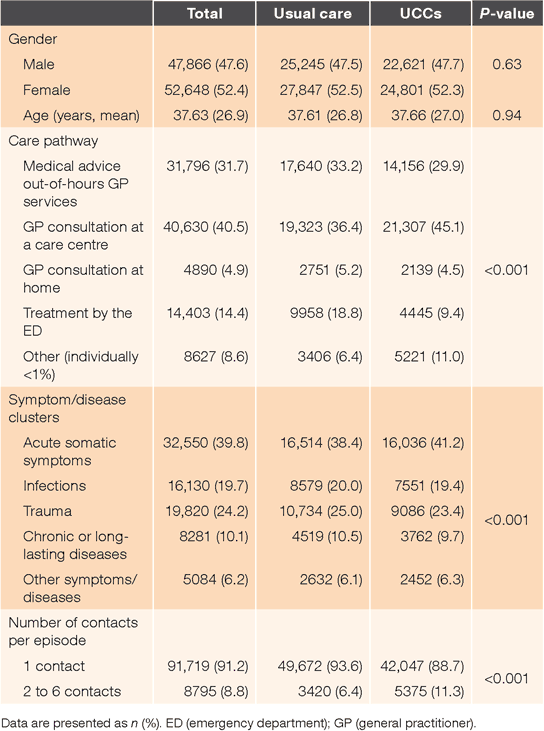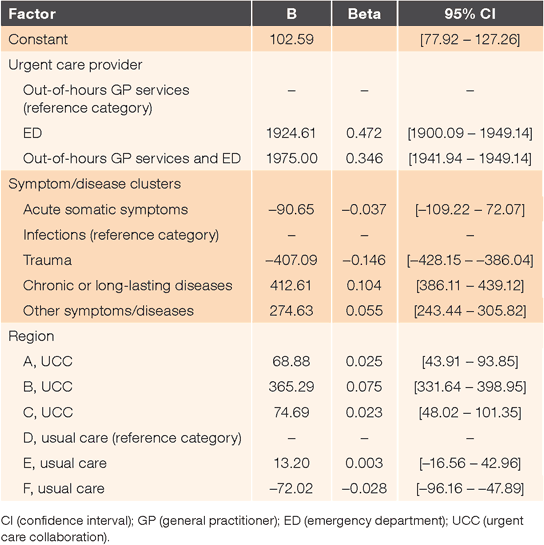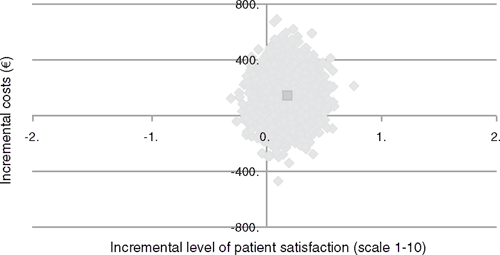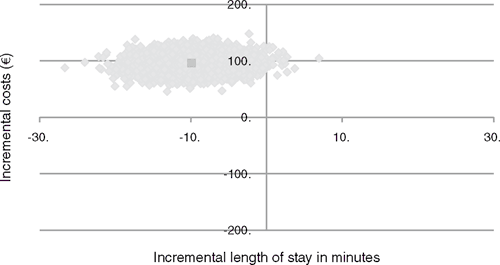Do out-of-hours general practitioner services and emergency departments cost more by collaborating or by working separately? A cost analysis
Sjoerd Broekman 1 , Elisabeth Van Gils-Van Rooij 2 , Berthold Meijboom 2 , Dingenus De Bakker 1 2 , Christoffel Yzermans 11 Netherlands Institute for Health Services Research, The Netherlands
2 Tilburg University Tranzo Scientific Centre for Care and Welfare, Tilburg, The Netherlands
Correspondence to: Sjoerd Broekman, Netherlands Institute for Health Services Research, 3513CR, Utrecht, The Netherlands. Email: sjoerd.broekman@gmail.com
Journal of Primary Health Care 9(3) 212-219 https://doi.org/10.1071/HC17015
Published: 25 September 2017
Journal Compilation © Royal New Zealand College of General Practitioners 2017.
This is an open access article licensed under a Creative Commons Attribution-NonCommercial-NoDerivatives 4.0 International License.
Abstract
INTRODUCTION: In the Netherlands, general practitioners (GPs) and emergency departments (EDs) collaborate increasingly in urgent care collaborations (UCCs) in which the two services share one combined entrance and joint triage.
AIM: The objective of this study is to determine if UCCs are cost-effective compared to the usual care setting where out-of-hours GP services and EDs work separately.
METHODS: This observational study compared UCCs with the usual care setting on costs by performing linear regression analyses. These costs were also combined with two performance indicators: level of patient satisfaction and the length of stay. A non-parametric bootstrap (resampling) method was performed in order to analyze the cost-effect pairs.
RESULTS: During the study period, 122,061 patients visited EDs and the out-of-hours GP services. Total mean costs per episode were substantially higher in UCCs: ?480 versus ?392 respectively. In this study, two factors that contributed to higher costs in UCCs compared to usual care were identified. First, there was a higher proportion of GP consultations instead of cheaper medical advice for self-care in UCCs. Second, in UCCs there were more often double costs per episode, as more patients were referred to an ED after triage or consulting GP services. The cost-effectiveness analyses show that UCCs were not dominant on cost-effectiveness compared to the usual care setting.
DISCUSSION: A substitution of, often self-referring, patients from EDs to GP services does not result in lower costs to society, a shorter length of stay or a higher level of patient satisfaction.
KEYWORDS: Urgent Care Collaboration; GP services; ED visits; costs
Introduction
Emergency Departments (EDs) are primarily focused on trauma. However, self-referred out-of-hours patients present often with minor, non-urgent health problems that generally can be treated by a general practitioner (GP) or do not require treatment at all.1,2 Patients indicate that their main reasons for visiting an ED are their perceived need for diagnostic facilities and the conviction that a hospital specialist is best qualified to handle their problem.3–5 Moreover, at the ED, patients are more likely to receive diagnostic tests and have follow-up contacts.1,6 High rates of inappropriate ED users may lead to overcrowding, increased waiting times and rising costs.7
In 2012, 44% of all ED patients in the Netherlands attended without being referred.8 In case of an emergency, or if advanced diagnostics are needed, these patients made the right decision; however, the attendance was inappropriate in 20–60% of all ED patients9–11 (Box 1).
| Box 1. Emergency care in the Netherlands12,13 | |
| |
Innovations in the organization of emergency health care
One means of tackling inappropriate attendance at emergency healthcare facilities is to employ a GP within the ED. Previous studies showed a significantly shorter length of stay, higher patient satisfaction and cost reductions in the new care setting.5,14–16
Another option is intensified cooperation between out-of-hours GP services and EDs in so-called Urgent Care Collaborations (UCCs), an innovation that is increasingly found in The Netherlands. In UCCs, out-of-hours GP services and EDs share one entrance and patients are, based on a system of triage, allocated to either the on-call GP or the ED.
Costs
In the past, it has been estimated that in the Netherlands, cost prices per ED contact are, on average, €65 higher than for GP contacts (€125 compared to €60).17 A cost analysis showed that the costs of self-referrers are three-fold higher in EDs compared to self-referrers in out-of-hours GP services.18 Van Uden et al.19 studied the costs from an organizational perspective. They reported slightly higher costs per inhabitant related to the GP service and equal total costs for the EDs in the integrated model versus the separate model, despite decreased patient numbers.19 To the best of our knowledge, no cost analysis on UCCs has been performed from a societal perspective. A previous study investigating the attendance per type of urgent care provider has shown that substantially fewer patients attend EDs during evening, night and weekend hours in UCCs than usual care where the out-of-hours GP services and the EDs work separately.20
Study objective and hypothesis
In the present study, which is part of a multi perspective study of cooperating emergency departments and GPs,21 a cost analysis is performed to discover if costs from a societal perspective are different in the collaborative setting than in the situation in which ED and GP service work separately. Our hypothesis is that the costs are lower in UCCs because, compared to the usual care setting, substantially fewer patients attended EDs during evening, night and weekend hours.
Methods
Study design
This study follows a cross-sectional observational design comparing three UCC regions with three usual care regions where out-of-hours GP services and EDs work separately. All are located in the southern part of the Netherlands, resulting in a cost regression analysis. The costs are paired with the performance indicators, length of stay and level of patient satisfaction on an individual patient level.
Population
Patients who contacted EDs or out-of-hours GP services between March–April and October– November 2011 during evening, night or weekend hours (5 pm to 8 am on weekdays, 5 pm Friday–8 am Monday) were included in this study. Cases that lacked a ZIP-code, age, gender, cost information or information about the medical service used were excluded.
Settings: UCCs and usual care
The usual care group consisted of patients who attended a GP or an ED or both in which both parties worked separately but were located within 5 km of each other. In this setting, patients could decide to contact the out-of-hours GP service, resulting in medical advice about possible self-care. It may also have led to a consultation at the GP practice or at the patient’s home. If necessary, the GP referred patients to an ED. However, patients could also attend the ED directly. At the out-of-hours GP services participating in this study, triage was performed by a medical assistant using the Netherlands Triage System (NTS)22 or Telephone Advice System (TAS). Within the EDs, triage was performed by a nurse, using the Manchester Triage System (MTS) or Emergency Severity Index (ESI). MTS and ESI are the most frequently implemented five-level triage systems in The Netherlands.23 Triage is used to assign a level of urgency: very urgent (U1) to non-urgent (U5).
The UCC group consisted of patients who attended a GP or ED in an UCC setting. The UCCs participating in this study were launched between December 2008 and March 2009. Within the UCCs, patients could not decide for themselves whether to contact a GP or ED as they shared a location, used joint triage and shared one, combined entrance. Based on a system of triage, patients were allocated to see either a GP or attend an ED, and were assigned a level of urgency. The triage of health problems presented by telephone was performed by a trained medical assistant. Health problems, presented on site, were triaged by a trained nurse. In both cases, the NTS22 was used. After triage, GPs and EDs each had their own department. A patient’s treatment was similar to care received within a usual care setting. The main difference between settings was how care was allocated.
The UCC and usual care regions are situated in rural as well as urban areas. Taken together, they have comparable numbers of inhabitants (538,000 vs. 533,000).
Data
Data on the patient’s gender and age were obtained from electronic medical records, together with their contact characteristics such as their care pathway, the number of contacts per episode, the time of check-in and discharge. Because cost prices can differ, as they are dependent on the outcome of negotiations with health insurance companies, average prices were used in this study. The average prices of the participating out-of-hours GP services were €85.85 for a GP consultation, €128.82 for a GP home visit and €25.00 for offering medical advice (by phone or at the desk) or triage when patients are directly referred to the ED. Hospital records were matched with national average prices per care product (a diagnosis and treatment combination) to determine ED prices.
Length of stay was defined as the moment of registration at the ED or out-of-hours GP service until the moment of discharge. The level of patient satisfaction with the organization was reported on a 0–10 scale (0 = poor; 10 = excellent), derived from the Consumer Quality Index (CQI)24 questionnaire. The mean evaluation score of the organization of the out-of-hours GP services and ED was calculated when a patient visited both the out-of-hours GP services and the ED in the usual care setting within one episode.
Statistical analyses
Data per contact was structured in episodes, using the criterion that a recurrent contact within 12 h belonged to the same episode. Episodes that crossed both usual care and UCC settings were excluded (0.3%). In total, 107,420 episodes were included in this study. Continuous variables were summarized separately for usual care and for UCCs as means and standard deviations (SD). Numbers and percentages were used for categorical variables. A linear regression analysis was conducted in order to examine the relationships between settings (independent) and costs (dependent). We checked for possible effect modification by means of a forward selection procedure looking at the region of care location, the care provider (GP/ED) and the symptom/disease cluster. We then paired the costs with the performance indicators, length of stay and level of patient satisfaction. To avoid the need to make assumptions about the shape of the distribution of the cost-effect pairs, a non-parametric bootstrap (resampling) method was performed. Incremental cost-effectiveness ratios (ICERs) were calculated by dividing the difference in costs by the difference in effects between the two settings. Bootstrapping with 5000 replications25 was used to estimate uncertainty surrounding the ICERs. In the first analysis of cost-effectiveness, 773 episodes were included by pairing the level of patient satisfaction and the total cost data. In the second analysis of cost-effectiveness, 53,289 episodes were included by pairing the length of stay and the total cost data. The bootstrapped cost-effect pairs were plotted on cost-effectiveness planes (CE planes).
The data were analysed using Stata 13 (StataCorp LLC, College Station, TX, USA) and IBM SPSS Statistics 21.0 (IBM Corp., Armonk, NY, USA). A two-tailed P-value of <0.05 was considered to be statistically significant.
Results
During the study period, 122,061 patients visited the EDs and out-of-hours GP services, of whom 63,441 visited the usual care setting and 58,620 the UCCs. Table 1 shows the population and contact characteristics per episode of patients using UCCs and the usual care setting. There were no statistically significant differences between settings for gender or age. In UCCs, there were, on average, 8.7% more GP consultations at the care centre and 9.4% fewer ED treatments. Also, a higher proportion of patients had more than one contact per episode in UCCs compared to the usual care setting. Finally, in the proportion of episodes per symptom per disease cluster, there were significant differences between both settings.

|
Costs
Table 2 presents the mean and total costs per episode in the UCCs and the usual care setting. The mean costs per episode were substantially higher in UCCs: €480 versus €392 respectively. Mean DTC costs were almost twice as high in UCCs compared with the usual care setting: €2,701 versus €1,369 respectively. At out-of-hours GP services, there were 2.3% fewer episodes and 1.00% higher costs in UCCs compared to the out-of-hours GP services in the usual care setting. Second, in EDs, there were 38.0% fewer episodes and 5.9% lower costs in UCCs compared to EDs in the usual care setting. Finally, in UCCs, there were 25.4% more episodes of patients who visited an ED after their visit to the out-of-hours GP service and 25.4% higher costs.

|
Multiple linear regression analyses (Table 3) show that the urgent care provider (GP or ED) and the symptom/disease cluster were strong predictors for the total costs, and that region was a stronger predictor than setting. The R2 value was 0.344: the final model was fit for analysis. The analyses show that visiting an ED is associated with higher costs compared to visiting a GP, and that there are significant differences between the symptom/disease clusters. The clusters: infections, acute somatic symptoms and trauma are associated with lower costs. Conversely, chronic and long-lasting diseases and other are associated with higher costs. In UCC region B, there are higher costs compared to UCC regions A and C. There are also significant cost differences within the usual care regions. Nevertheless, in the final model, the three UCC regions have significantly higher costs compared to the reference region.

|
Costs paired with performance indicators
Table 4 shows the calculated ICERs and quadrant distributions on the CE planes, which are visualized in Figures 1 and 2. The bootstrapped cost-effect pairs indicate that the UCC setting is not dominant on cost-effectiveness. The differences in costs and effects for the subsample of patients for whom data on patient satisfaction and cost data (n = 773) were available, show no statistical significance. However, the differences for the subsample of patients for whom data on costs and length of stay were available (n = 53,289) show statistical significance. The incremental costs were +€96.02 (95% CI 69.18 to 121.85) and the incremental length of stay was –9.92 min (a negative effect means a longer length of stay in UCCs) (95% CI –16.99 to –2.21). The ICERs were both positive (respectively 821 and 542).

|

|

|
Discussion
This study shows that, overall, the mean costs per episode in UCCs were higher than in the usual care setting. This contradicts the hypothesis. The expectation was that the difference in patient flow would lead to lower costs in UCCs compared to the usual care setting.
There are a few explanations for these findings. First, the costs of out-of-hours GP services were higher because in UCCs, relatively more patients received a GP consultation (€128.82) instead of medical advice per telephone (€25,00). Second, total costs were higher because of double ED and GP costs in UCCs for self-referrers who attended the ED (costs per care product) directly after triage by the GP services (€25,00 for triage), and also because there were more patients who had contacted both a GP and ED physician within one episode in UCCs. An explanation for the latter is that the threshold to refer patients to an ED for a second opinion was probably lower for GPs working in UCCs. Third, the lower number of self-referrers to EDs may not have resulted in lower mean costs per episode because the less urgent cases, as well as patients with minor trauma, only represent a small proportion of the costs in the usual care setting. Finally, it has been shown that hospitals sometimes register more expensive diagnoses than medically required.26 We cannot rule out this so-called “upcoding”. When, in a market of regulated competition, fewer patients attend the ED, as is the case in UCCs compared to usual care, there might be a higher interest for hospitals to compensate this by promoting more expensive treatments.26,27 The possibility that differences between the UCC and usual care setting were caused by differences in negotiated prices between health insurance companies and care providers can be ruled out because we have corrected for this effect by using average prices.
Costs related to performance indicators
UCCs were less cost-effective than the usual care setting. Regarding the length of stay, usual care setting performed better on cost-effectiveness than UCCs; costs were higher (+€96.02) and the length of stay longer (+9.92 min). The differences can be attributed to the longer length of stay in the GP services, whereas the length of stay was shorter at the EDs within the UCCs. The effect sizes were small but significant due to the sample size.
There were no significant differences in the level of patient satisfaction between settings. There are two possible explanations for this outcome. The fact that there is one location and one combined entrance in an integrated setting does not necessarily imply that GPs, medical staff and physicians treat patients better or will provide patients with more and better information. Likewise, other factors such as hygiene and safety are also not influenced by integrating GPs and EDs. Patients in the usual care setting are already quite satisfied with the quality level of care and care providers (7.90/10.0), therefore the potential for a higher level of patient satisfaction in UCCs is minimal.
Strengths and limitations
To the best of our knowledge, this was the first study examining costs on such a large scale, comparing three UCCs with three usual care regions and 122,061 patient contacts during the study period. The fact that there are different funding systems in the Netherlands for GPs (payment per contact) and hospital care (payment per care path via the DTC system) complicates a valid analysis on costs, regardless of the study method. Unfortunately, it was not possible to perform a longitudinal study and we did not investigate follow-up costs. The cost-effectiveness analysis we performed is a powerful tool to gain insight into both costs and performance indicators. An important advantage of this tool is that it corrects for highly skewed cost data.
Implications for further research and clinical practice
UCCs seem to have become the standard model for organizing emergency care in the Netherlands. Therefore, the Dutch government should consider changing the way of financing emergency care to prevent double costs incurred by EDs and GP services. Further research should aim to find explanations for the cost differences between regions because we found that this was a stronger predictor than setting. More research is needed to examine how the financing of out-of-hours GP services, and EDs, while respecting the differences per region, can be aligned in order to fit in with the unique elements of emergency care.
Conclusions
This study shows that a substitution of, often self-referring, patients from EDs to GP services does not result in lower costs, a shorter length of stay or a higher level of patient satisfaction.
FUNDING
This research was financed by ZonMw, The Netherlands Organisation for Health Research and Development, The Netherlands Institute for Health Services Research (NIVEL), Scientific Center for Transformation in Care and Welfare (Tranzo, Tilburg University) and the out-of-hours GP service, Oost-Brabant.
COMPETING INTERESTS
Elisabeth van Gils-van Rooij performed this research as a science practitioner at Tranzo, Tilburg University. She was also employed by one of the study subjects.
ACKNOWLEDGEMENTS
The authors thank the staff of the hospitals and GP cooperatives for the invaluable contribution of their time and effort in participating in this study. Furthermore, we thank DTC Maintenance for providing national average cost prices and ZonMw for financing this project. We are grateful to Harald Abrahamse for his help in preparing the data set and Peter Spreeuwenberg for assisting with the statistical analyses.
References
[1] Huibers L, Thijssen W, Koetsenruijter J, et al. GP cooperative and emergency department: an exploration of patient flows. J Eval Clin Pract. 2013; 19 243–9.[2] Giesen P, Franssen E, Mokkink H, et al. Patients either contacting a general practice cooperative or accident and emergency department out of hours: a comparison. Emerg Med J. 2006; 23 731–4.
| 1:STN:280:DC%2BD28vpsVKqtA%3D%3D&md5=5664467b13164f0921fa09fb46cdec38CAS |
[3] Lee A, Lau FL, Hazlett CB, et al. Factors associated with non-urgent utilization of Accident and Emergency services: a case-control study in Hong Kong. Soc Sci Med. 2000; 51 1075–85.
| 1:STN:280:DC%2BD3cvltVCisg%3D%3D&md5=0ed246d2fa7f3a02e2391187acba8518CAS |
[4] Moll van Charante EP, ter Riet G, Bindels P. Self-referrals to the A8E department during out-of-hours: patients’ motives and characteristics. Patient Educ Couns. 2008; 70 256–65.
[5] Ward P, Huddy J, Hargreaves S, et al. Primary care in London: an evaluation of general practitioners working in an inner city accident and emergency department. J Accid Emerg Med. 1996; 13 11–5.
| 1:STN:280:DyaK28vhvVCgsw%3D%3D&md5=a3afc9b6a0ebed9423eb543cd7513dc5CAS |
[6] Dale J, Green J, Reid F, Glucksman E. Primary care in the accident and emergency department: I. Prospective identification of patients. BMJ. 1995; 311 423–6.
| 1:STN:280:DyaK2Mzmsl2nsw%3D%3D&md5=0eb9aff7fb7291666b65afcc73b096aaCAS |
[7] Derlet R, Richards J, Kravitz R. Frequent overcrowding in U.S. emergency departments. Acad Emerg Med. 2001; 8 151–5.
| 1:STN:280:DC%2BD3M3gtlOnug%3D%3D&md5=e1bd688c73c8a20f92cb37ff074baa95CAS |
[8] Van Erkelens JA, Van Galen MS, Van Gorp T, et al. Zorgthermometer [Health care monitor]. Vooruitblik 2014 [Prospective 2014] [serial on the Internet]. 2013; 18. [cited 2016 June 9]. Available from: http://www.vektis.nl/downloads/Publicaties/2013/Zorgthermometer%20-%20Vooruitblik%202014/index.html#34/z
[9] Jaarsma-van Leeuwen I, Hammacher ER, Hirsch R, Janssens M. Patiënten zonder verwijzing op de afdeling Spoedeisende Hulp: patiëntkarakteristieken en motieven Ned Tijdschr Geneeskd. 2000; 144 428–31. [Patients without referral treated in the emergency room: patient characteristics and motives]
| 1:STN:280:DC%2BD3c7osVClsw%3D%3D&md5=eee1592a9e83c775e6281206ef052611CAS |
[10] Ijzermans CJ, Mentink S, Klaphake LM, et al. Contacten buiten de kantooruren: klachten gepresenteerd aan de huisarts en aan de Spoedeisende Hulp Ned Tijdschr Geneeskd. 2002; 146 1413–7. [Contacts outside of office hours: complaints presented to the general practitioner and to the emergency department]
| 1:STN:280:DC%2BD38vitVagtA%3D%3D&md5=e7c3bea0502d8efb83c9d0b2be0dbb82CAS |
[11] Carret ML, Fassa AC, Domingues MR. Inappropriate use of emergency services: a systematic review of prevalence and associated factors. Cad Saude Publica. 2009; 25 7–28.
[12] NZa. Werken met DBC's [Working with Diagnostic Treatment Combinations]. Utrecht: Nederlandse Zorgautoriteit; 2015. [cited 2015 June 09]. Available from: http://werkenmetdbcs.nza.nl/dbc-systematiek.
[13] Schäfer W, Kroneman M, Boerma W, et al. Health system review. Health Syst Transit. 2010; 12 v–xxvii.
[14] Boeke AJ, van Randwijck-Jacobze ME, de Lange-Klerk EM, et al. Effectiveness of GPs in accident and emergency departments. Br J Gen Pract. 2010; 60 e378–84.
[15] Bosmans JE, Boeke AJ, van Randwijck-Jacobze ME, et al. Addition of a general practitioner to the accident and emergency department: a cost-effective innovation in emergency care. Emerg Med J. 2012; 29 192–6.
[16] Dale J, Lang H, Roberts JA, et al. Cost effectiveness of treating primary care patients in accident and emergency: a comparison between general practitioners, senior house officers, and registrars. BMJ. 1996; 312 1340–4.
| 1:STN:280:DyaK283jtlCnsQ%3D%3D&md5=f60ebdfe70660b536be547e27a273aebCAS |
[17] De Huisartsenpost VHN. Armslag voor een goed eerstelijns loket. 2015. In: InEen, VHN. Utrecht: InEen. [cited 2016 June 09]. Available from: http://docplayer.nl/10082989-De-huisartsenpost-armslag-voor-een-goed-eerstelijns-loket.html
[18] Giesbers S. Spoedeisende hulp en huisartsenzorg: een kostenanalyse [Emergency department and GP care: a cost analysis]. Nijmegen: UMC St Radboud; 2010.
[19] van Uden CJ, Ament AJ, Voss GB, et al. Out-of-hours primary care. Implications of organisation on costs. BMC Fam Pract. 2006; 7 29
[20] van Gils-van Rooij ESJ, Yzermans CJ, Broekman SM, Meijboom BR, De Bakker DH. Out-of-hours care collaboration between general practitioners and hospital emergency departments in the Netherlands. J Am Board Fam Med. 2015; 28 8
[21] Van Gils-van Rooij ESJ. The paradox of urgent care collaborations: a multi perspective study of cooperating emergency departments and general practitioners Amersfoort: Wilco. Doctoral thesis, Tilburg University, Tilburg, The Netherlands; 2016. Available from: https://pure.uvt.nl/ws/files/12403683/Van_Rooij_The_paradox_29_06_2016.pdf.
[22] van Ierland Y, van Veen M, Huibers L, et al. Validity of telephone and physical triage in emergency care: the Netherlands Triage System. Fam Pract. 2011; 28 334–41.
[23] van der Wulp I. Reliability and validity of emergency department triage systems. Utrecht: Universiteit Utrecht; 2010.
[24] Delnoij DM, Rademakers JJ, Groenewegen PP. The Dutch consumer quality index: an example of stakeholder involvement in indicator development. BMC Health Serv Res. 2010; 10 88
[25] Black WC. The CE plane: a graphic representation of cost-effectiveness. Med Decis Making. 1990; 10 212–4.
| 1:STN:280:DyaK3czhvVaiug%3D%3D&md5=a222dee40b8fc8f24b1914fe6627d7feCAS |
[26] Hassaart F. Incentives in the Diagnosis Treatment Combination payment system for specialist medical care. Maastricht: Maastricht University; 2011.
[27] Dafny LS. How do hospitals respond to price changes? Am Econ Rev. 2005; 95 22


